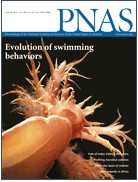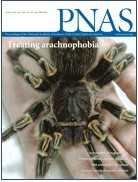PNAS:研究者揭示婴儿如何调查环境
2012-07-03 EurekAlert! EurekAlert!
一项刊登在PNAS上的研究揭示,婴儿通过看和注意的截然不同的过程之间的相互作用从而调查他们所处的环境。科研人员已经了解了婴儿的迅速发育的许多方面,但是婴儿收集他们所在世界的视觉信息的方式仍然没有得到很好的理解。Steven S. Robertson及其同事使用脑电图研究了12周龄婴儿看一个发出闪烁的光的黄色玩具鸭时候的大脑响应。 这个测试证实了对这个玩具鸭的注意调控了类似地出现在婴儿和成人身上的
一项刊登在PNAS上的研究揭示,婴儿通过看和注意的截然不同的过程之间的相互作用从而调查他们所处的环境。科研人员已经了解了婴儿的迅速发育的许多方面,但是婴儿收集他们所在世界的视觉信息的方式仍然没有得到很好的理解。Steven S. Robertson及其同事使用脑电图研究了12周龄婴儿看一个发出闪烁的光的黄色玩具鸭时候的大脑响应。
这个测试证实了对这个玩具鸭的注意调控了类似地出现在婴儿和成人身上的由闪光驱动的脑电振荡。这组科研人员然后向33名婴儿组成的更大的群体展示了3只玩具鸭,它们的闪光频率各不相同。通过分析脑电信号和婴儿凝视之间的相互作用,这组科研人员发现婴儿在把他们的目光转向这个物体之前暗暗地注意了外周物体。
对下一个目标的隐秘的注意在眼运动开始之前增加,然后这些婴儿把目光从最近的隐秘注意的主要目标上移开。这组作者说,这种视觉搜寻模式让有效探索复杂环境成为可能,而且可能支持其他搜寻行为的出现,例如之后数周的有技巧的伸手和抓握。

doi:10.1073/pnas.1203482109
PMC:
PMID:
Attentional dynamics of infant visual foraging
Steven S. Robertsona,1, Sarah Enos Watamurab, and Makeba Parramore Wilbournc
Young infants actively gather information about their world through visual foraging, but the dynamics of this important behavior is poorly understood, partly because developmental scientists have often equated its essential components, looking and attending. Here we describe a method for simultaneously tracking spatial attention to fixated and nonfixated locations during free looking in 12-week-old infants using steady-state visual evoked potentials (SSVEPs). Using this method, we found that the sequence of locations an infant inspects during free looking reflects a momentary bias away from locations that were recently the target of covert attention, quickly followed by the redirection of attention—in advance of gaze—to the next target of fixation. The result is a pattern of visual foraging that is likely to support efficient exploration of complex environments by facilitating the inspection of new locations in real time.
本网站所有内容来源注明为“梅斯医学”或“MedSci原创”的文字、图片和音视频资料,版权均属于梅斯医学所有。非经授权,任何媒体、网站或个人不得转载,授权转载时须注明来源为“梅斯医学”。其它来源的文章系转载文章,或“梅斯号”自媒体发布的文章,仅系出于传递更多信息之目的,本站仅负责审核内容合规,其内容不代表本站立场,本站不负责内容的准确性和版权。如果存在侵权、或不希望被转载的媒体或个人可与我们联系,我们将立即进行删除处理。
在此留言














#研究者#
56
#PNAS#
64